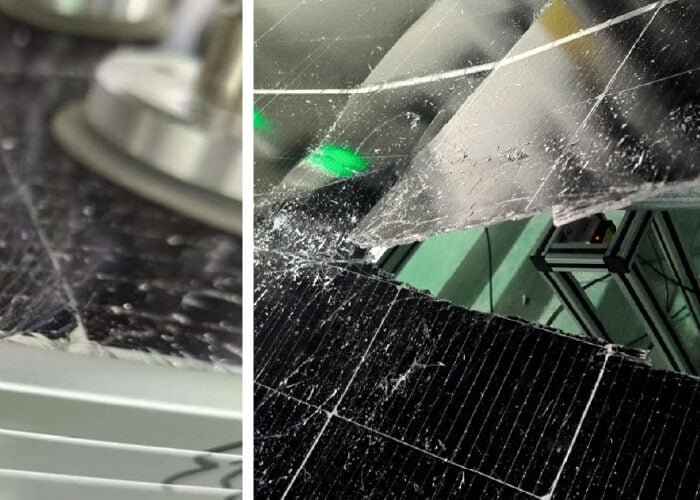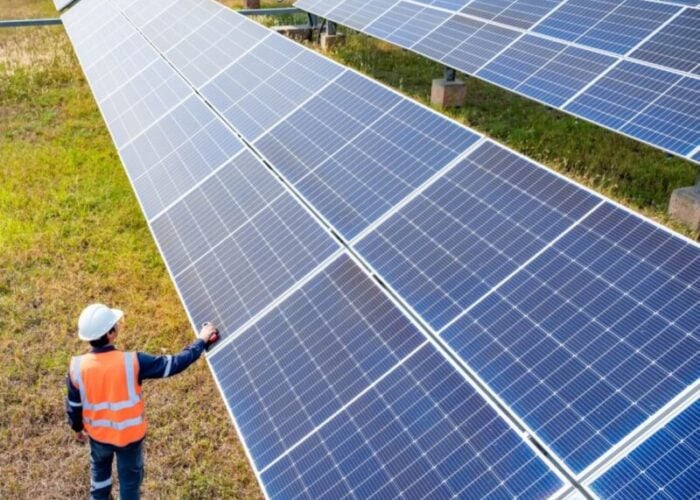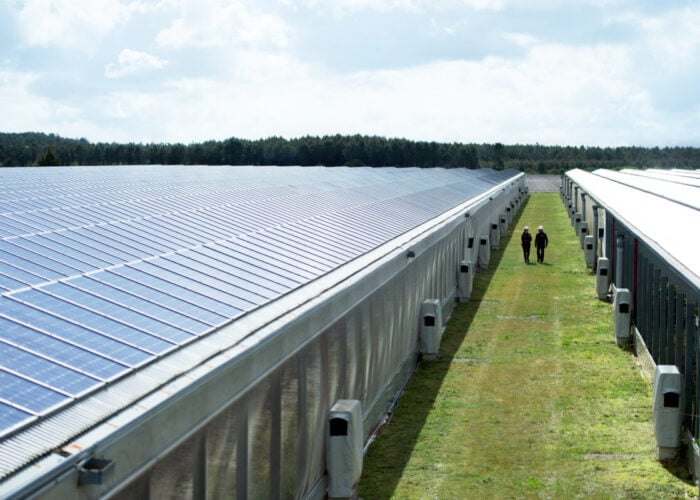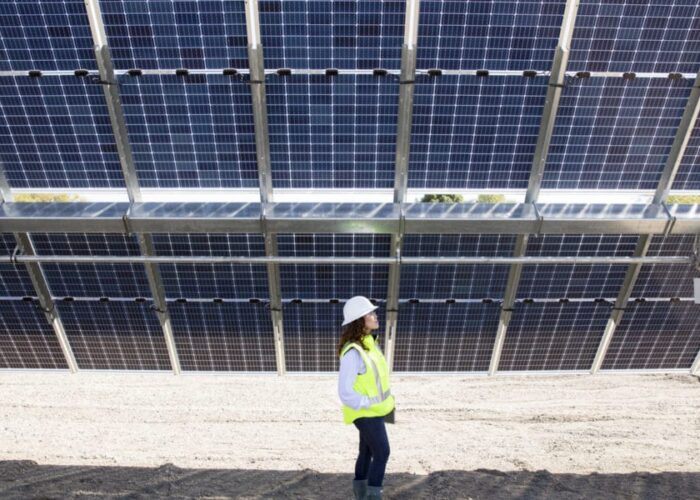Such has been the speed at which solar module prices have fallen in the past few years that other elements of a PV system’s installed cost have failed to keep up. According to a recent GTM Research study, despite falling overall, balance-of-system (BOS) costs as a proportion of the total installed cost of a typical residential PV system actually increased between 2007 and 2015, from 58% to 77%.
Within the total BOS equation, which encompasses all non-module elements of a PV system, one of the persistent offenders has been soft cost – expenditures relating to non-hardware BOS such as permitting, labour, finance, customer acquisition and so on. High soft costs are a particular issue in the USA, where they account for significant proportion of overall cost, especially in the residential segment.
Unlock unlimited access for 12 whole months of distinctive global analysis
Photovoltaics International is now included.
- Regular insight and analysis of the industry’s biggest developments
- In-depth interviews with the industry’s leading figures
- Unlimited digital access to the PV Tech Power journal catalogue
- Unlimited digital access to the Photovoltaics International journal catalogue
- Access to more than 1,000 technical papers
- Discounts on Solar Media’s portfolio of events, in-person and virtual
“Soft costs have come down – but they haven’t matched the speed with which hardware costs have fallen,” says MJ Shiao, director of solar research at GTM. “To put some numbers behind that, if we look at soft costs of the overall system, it’s about 60% of residential cost in 2015 [in the US]. And if you look at just BOS, soft costs are more along the lines of about 75% of residential BOS.”
With the US investment tax credit (ITC) due to be eradicated entirely for residential PV systems and to be significantly slashed for larger projects at the end of 2016, now more than ever the heat is on for the industry to remain competitive. Module costs will continue to fall incrementally as more efficient cell technologies are developed, but soft costs still offer significant headroom for further reductions.
The good news is that the trajectory for soft costs appears now to be on a determinedly downward trajectory in the US, across utility, commercial and residential segments. The Department of Energy’s Sunshot Initiative has set some specific targets for overall soft-cost reductions (see Figure 1), and all three sectors are over half way towards achieving these goals with half of the programme still to run. But in the residential segment particularly progress has been slower, and the verdict is that with US being the complex and varied market that it is, there is still plenty of work to be done.
“The US is a very fractured market, with thousands of jurisdictions each with their own unique set of rules and regulations,” says David Feldman, an analyst for the National Renewable Energy Laboratory (NREL). “In some places the interconnection and permitting processes are both long and cumbersome and potentially costly. And so there’s been a lot of movement recently in a bunch of places to streamline those processes and to make them more efficient and long-term sustainable.”
Indeed, dealing with the fragmented nature of the US market has been and remains one of the core focuses of the Sunshot Initiative. Speaking to PV Tech Power, Elaine Ulrich, Sunshot’s soft cost and BOS programme manager, cites some numbers that lay bare just how complex a place the US can be for solar companies to do business.
“One of the root causes of the soft cost issues we have here is that we have 50 states, 18,000 jurisdictions and about 3,000 utilities,” Ulrich says. “And some of those utilities are investor-owned, some are municipal, some cooperatives. So the regulations, the standards and the codes that are applied can vary extremely widely.”
Ulrich says Sunshot has been working on a number of fronts to help relevant actors get to grips with solar, an energy source many are still unfamiliar with. “We do a lot of technical assistance work, helping states and localities to understand what solar is, to implement programmes and practices that are enabling for solar deployment, and we help to put them into networks so they can learn from one another,” Ulrich explains.
This work has evolved over time, beginning with a programme that targeted a number of city authorities in the US that wanted to remove the barriers to solar deployment. “They developed some best practices, whether it was looking at what a standardised permit would look like, training officials or local policies that would help,” Ulrich says.
Some of the best practices developed through this venture were then fed into a larger ‘rooftop solar challenge’ initiative, which had a much broader regional focus than its forebear, adds Ulrich. The next step in the process is the recently launched ‘Solar Powering America by Recognising Communities’ programme, which is aiming to develop a designation programme to recognise communities that have taken steps to become more ‘solar friendly’ by addressing local soft cost issues.
“Through the learning from prior programmes we now know what those impactful measures are that, once implemented, make a market open to solar,” Ulrich explains. “Communities will have a checklist of things they can do, with a point value associated with the various actions they take; as they implement some of those things, they can become designated as some kind of ‘solar-friendly’ community. We’re still working on what that designation would look like. But we want to keep pushing the standard forward as the market continues to evolve and again we want to make sure we are including metrics that help to expand access to solar electricity to a broader and broader range of consumers.”
Another focus for driving down costs is the so-called customer acquisition process – the costs related to generating sales leads and turning those leads into business. According to Feldman, in places like Germany, which is a much smaller country than the US but now has a large installed base of PV, that cost will be much lower as there is generally much more awareness of solar energy and its benefits. But in parts of the US where penetration is much lower, the customer acquisition process will be harder and more costly. “People are tackling customer acquisition differently – and some are more successful than others,” he says.
GTM’s Shiao explains that the problem with the US as far as customer acquisition goes is, again, its size and fragmentation and the different incentives (or lack thereof) available in different geographies. This makes the selling point of a solar system something that is harder to communicate to potential clients in different areas.
“In general we haven’t seen any real rules of thumb when it comes to customer acquisition; just because you hit scale doesn’t mean that your overall cost of acquisition is necessarily going to fall,” he says. “A lot of people are tackling it either through borrowing ideas from other parallel markets like retail electricity markets, or trying to tap into software innovations that can help with the management of customer relationships behind the scenes. So again this a US-residential specific problem in many ways, but it is something where we’ll see the industry continue to have a big eye towards reducing.”
Technology innovation
And of course, despite the name, ‘soft’ costs cannot be separated from the technology side of the business; although much of the collective effort to drive soft costs down will be focused on streamlining processes and procedures, getting the hardware right will also be critical in tackling one of the biggest soft costs of all – namely labour. This can be as much as US$0.50/Watt in a residential system, and although less in utility and commercial systems, is still a big outlay.
Earlier this year, the CEO of First Solar, James Hughes, referenced in an analyst call how his company was changing the “means and methods” involved in constructing a PV power plant to reduce the number of actions and amount of time it takes to install. Clearly First Solar’s emphasis is on utility-scale projects, where arguably the most work has already been done to streamline plant design and construction process, but the same point applies to commercial and residential installations.
Shiao says this principle explains the growing popularity of three-phase string inverters. “If you design a system for a rooftop, and then get to the roof and you look at it again and realise you have made a big mistake, you have to redesign the system. With a string inverter you can pull off 30kW or add 30kW, whatever the string inverter unit is, and you might be fine – versus a central inverter where you have to maybe completely redesign the system. So those little things just add up and are part of the soft-cost reduction package,” he says.
Looking ahead, Shiao identifies racking as one area where there is still an opportunity to reduce the amount of labour involved. “A lot of people don’t view racking as particularly sexy, but it is one of the most time-consuming activities – thinking about how to get racking to the roof, getting it in place and what sort of activity is needed to secure the module,” Shiao says.
“We’re seeing a lot of innovation. When we talk about rooftop systems we’re almost entirely talking about these modular systems now – where you’re not setting up these long rails or these long units on the roof because it’s faster. Then thinking about the attachment method of how you secure the panel to the racking system itself, folks have moved to a one-tool system or even a click-in system, where you don’t need a tool to put it together. Those are seemingly small things, but when you’re talking about a field of thousands of modules, that time really does add up.”
It will be through technical innovation such as this, and the ongoing efforts to educate and support the various actors who could be a help rather than hindrance to solar, that the objectives of the Sunshot programme will be achieved and soft costs driven down. Overall GTM in its recent BOS analysis predicted only a small fall in the overall proportion of system costs represented by soft costs between now and 2020. But even that small percentage drop could represent a potentially significant contribution towards solar’s overall cost competitiveness and ability to keep on growing.
“In general as an overall proportion of system costs we don’t see [soft costs] changing all that much,” Shiao says. “Right now it’s about 60%, we think it will move to about 56-57% by 2020 for US residential. But those cost reductions are necessary – what it means is there are cost reductions across the board. We have to continue to reduce aggressively soft costs at least in line with hardware cost reductions in order to grow the industry.”
This article originally appeared in Volume 5 of PV Tech Power. To read more in-depth articles from the magazine, click here.
Innovations driving down solar soft costs
‘Plug-and-play’ technology Fraunhofer CSE, the US arm of the German research body, received a Sunshot grant to develop easy-to-install rooftop PV systems aimed at cutting labour time. CSE’s system incorporates new technologies such as lightweight modules and simplified mounting and wiring and measures to simplify the interconnection, permitting and inspection processes.
Automated permitting US installer Sunrun and Clean Power Research are trialling a new software platform that automates the solar permitting and interconnection process. The many thousands of separate jurisdictions handling this process across the US mean a patchwork of different rules and regulations, adding up to four weeks to average permitting times, according to Sunrun. The system is aiming to cut this time in half.
‘Race to 7-Day Solar’ This Sunshot programme is awarding up to US$10 million for the best new methods for bringing down the permit to plug-in time for solar systems to seven days for ≤100kW systems and seven weeks for ≤1MW systems. Twenty teams are involved in the programme, which kicked off in September 2015 and will run for 18 months.






